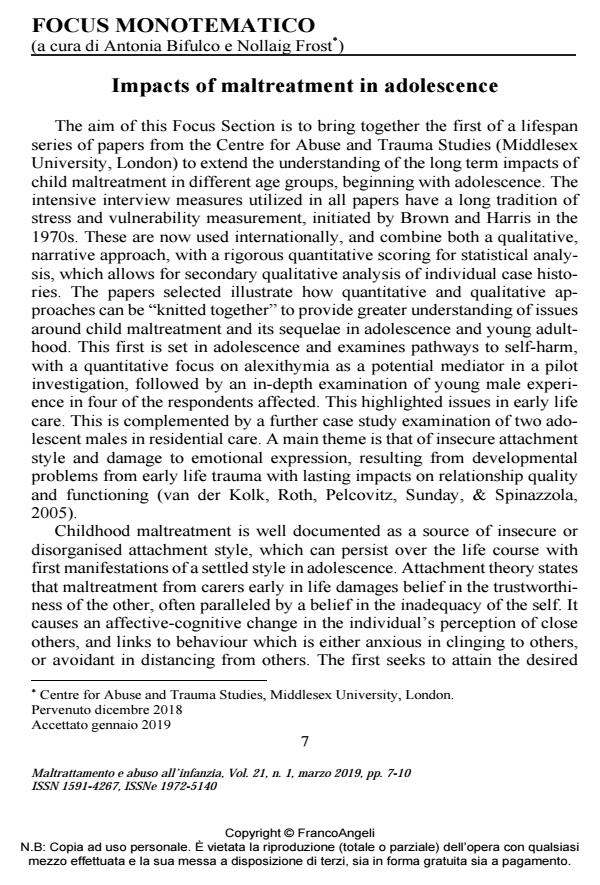Impacts of maltreatment in adolescence
Titolo Rivista MALTRATTAMENTO E ABUSO ALL’INFANZIA
Autori/Curatori Antonia Bifulco, Nollaig Frost
Anno di pubblicazione 2019 Fascicolo 2019/1 Lingua Italiano
Numero pagine 4 P. 7-10 Dimensione file 142 KB
DOI 10.3280/MAL2019-001001
Il DOI è il codice a barre della proprietà intellettuale: per saperne di più
clicca qui
Qui sotto puoi vedere in anteprima la prima pagina di questo articolo.
Se questo articolo ti interessa, lo puoi acquistare (e scaricare in formato pdf) seguendo le facili indicazioni per acquistare il download credit. Acquista Download Credits per scaricare questo Articolo in formato PDF

FrancoAngeli è membro della Publishers International Linking Association, Inc (PILA)associazione indipendente e non profit per facilitare (attraverso i servizi tecnologici implementati da CrossRef.org) l’accesso degli studiosi ai contenuti digitali nelle pubblicazioni professionali e scientifiche
- Bifulco, A., Moran, P. M., Ball, C., & Lillie, A. (2002). Adult attachment style. II: Its relationship to psychosocial depressive-vulnerability. Social Psychiatry & Psychiatric Epidemiology, 37, 60-67.
- Bifulco, A., Jacobs, C., Ilan-Clarke, Y., Spence R., & Oskis, A. (2017). Adolescent Attachment Style in Residential Care: The Attachment Style Interview and Vulnerable Attachment Style Questionnaire. British Journal of Social Work, 47, 1870-1883.
- Campbell, L., Keegan, A., Cybulska, B., & Forster, G. (2007). Prevalence of mental health problems and deliberate self-harm in complainants of sexual violence. Journal of Forensic and Legal Medicine, 14(2), 75-78.
- Crittenden, P. M. (1997). Toward an integrative theory of trauma: A dynamic-maturation approach. In D. Cicchetti & S. L. Toth (Eds.), Developmental perspectives on trauma: Theory, research and intervention (pp. 33-84). Rochester, New York: University of Rochester.
- Frost, N. A., & Nolas, S. M. (2013). The contribution of pluralistic qualitative approaches to mixed methods evaluations. In D. M. Mertens & S. Hesse‐Biber (Eds.), New directions for evaluation (pp. 75-84). London: Wiley.
- Liotti, G. (2004). Trauma, dissociation, and disorganized attachment: Three strands of a single braid. Psychotherapy: Theory, Research, Practice, Training, 41, 472-486. DOI: 10.1037/0033-3204.41.4.472.
- Main, M., & Hesse, E. (1990). Parents’ unresolved traumatic experiences are related to infant disorganized attachment status: Is frightened and/or frightening parental behavior the linking mechanism? In M. T. Greenberg, D. Cicchetti, & E. M. Cummings (Eds.), The John D. and Catherine T. MacArthur Foundation series on mental health and development. Attachment in the preschool years: Theory, research, and intervention (pp. 161-182). Chicago: University of Chicago Press.
- Nolas, S. M. (2008). Disrupting the emancipatory narrative: An ethnographic study of participation in a youth inclusion programme. London: London School of Economics and Political Sciences.
- van der Kolk, B. A., Roth, S., Pelcovitz, D., Sunday, S., & Spinazzola, J. (2005). Disorders of extreme stress: The empirical foundation of a complex adaptation to trauma. Journal of Traumatic Stress, 18, 389-399.
- van Ijzendoorn, M. H. (1997). Attachment, emergent mortality, and aggression: Towards a developmental socioemotional model of antisocial behaviour. International Journal of Behavioral Development, 21, 703.
- Webb, L. P. (2002). Deliberate self-harm in adolescence: A systematic review of psychological and psychosocial factors. Journal of Advanced Nursing, 38(3), 235-244.
Antonia Bifulco, Nollaig Frost, Impacts of maltreatment in adolescence in "MALTRATTAMENTO E ABUSO ALL’INFANZIA" 1/2019, pp 7-10, DOI: 10.3280/MAL2019-001001